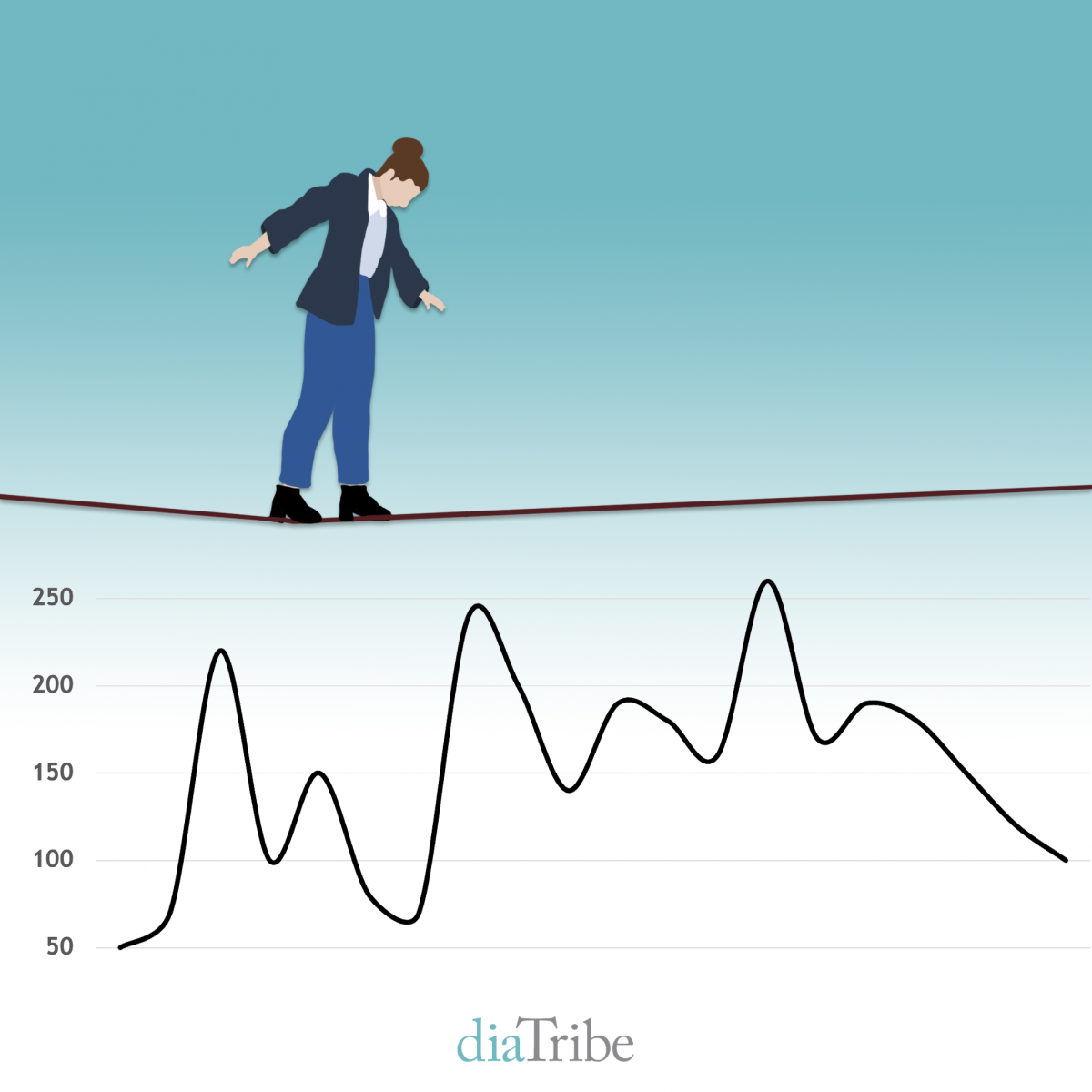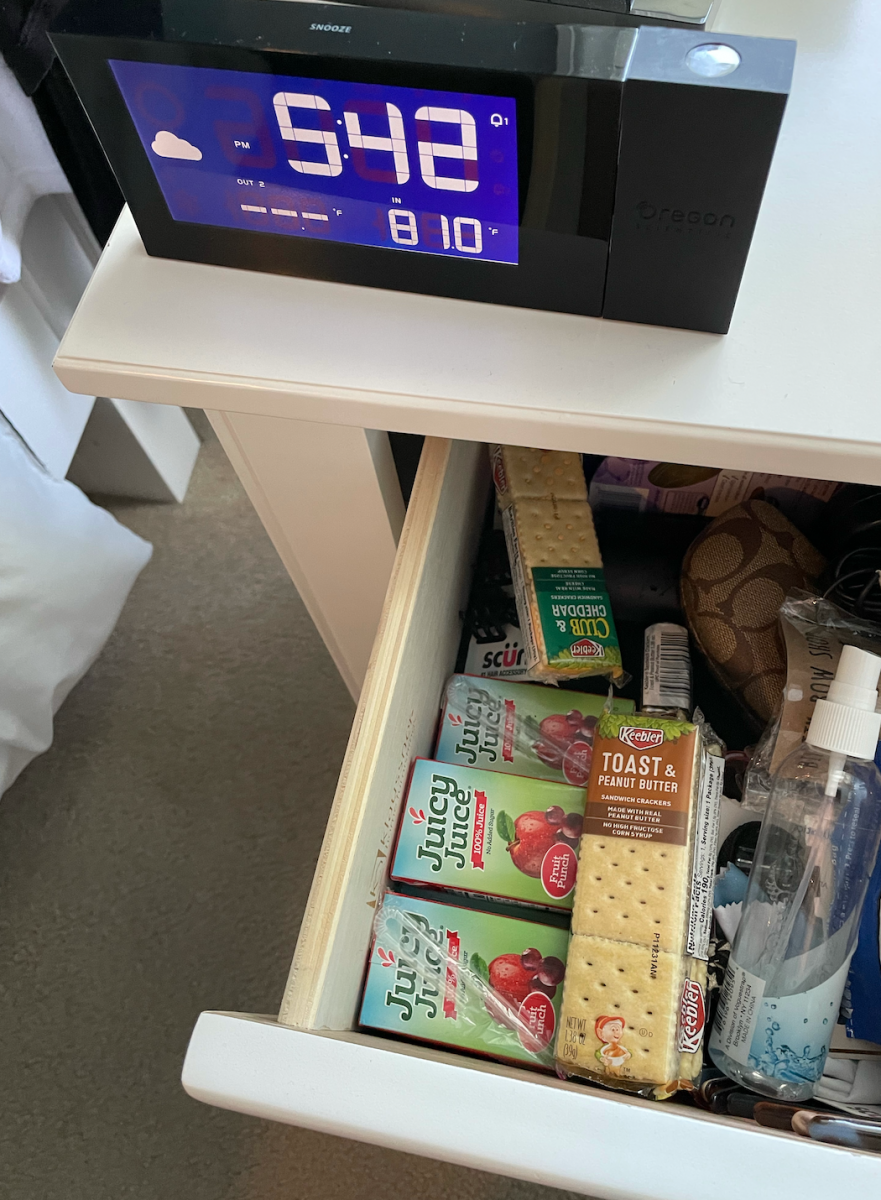Walking a Tightrope – Dealing with the Highs and Lows
By Julie Heverly
 Julie Heverly describes one harrowing day when her glucose levels teetered between way too high and way too low and how she navigated this challenge.
Julie Heverly describes one harrowing day when her glucose levels teetered between way too high and way too low and how she navigated this challenge.
For me, life with diabetes is like walking on a tightrope. Sometimes my course is set, and I can navigate to the ledge on the other side gracefully. Yes, it’s difficult, and yes, it requires skills, knowledge, the right equipment, and bravery (and even some luck), but it’s doable. But other days, a big wind blows through, and that delicate tightrope act is put in jeopardy.
I recently experienced one of those really bad windstorms, and it knocked me right off the tightrope.
To help me stay in range, I wear a continuous glucose monitor (CGM) and a closed-loop insulin pump that can give me small doses of insulin (micro doses) when my glucose levels are high and that can halt insulin delivery when my glucose levels are dropping or anticipated to become below my desired range. It’s a helpful system that assists my daily management quite well overall. It is not, however, a fool-proof system or a cure.
On this particular day, I woke up determined to stay in range (as is my daily mindset). At 5:30 am my alarm clock went off. I exercised for an hour on the elliptical, showered, and got myself and my family ready for the day. I chose the same breakfast I’ve been eating for the past six months – low fat cottage cheese and fresh berries. Shortly after breakfast though, my glucose started creeping into the 300s, where it stayed, despite my best efforts, until 9:30 p.m.
That entire day, my stomach was nauseous, my head was foggy, and my mood resembled Oscar the Grouch. I tried my best to bring my glucose down just as I have been taught:
-
I calculated correction boluses through my pump.
-
I selected low carb meals for lunch and dinner, and I pre-bolused 15 minutes in advance for both meals.
-
I changed my pump site in case the canula had kinked.
-
I used a new vial of insulin in case the old one had turned bad.
-
I took a walk after dinner.
-
I hydrated myself throughout the day (I personally aim to drink half my body weight in ounces each day).
-
And finally, I even resorted to a manual injection correction.
It didn’t help, at least not at first. But as we all know, what goes up, must come down.
 By 10:30 pm, my stomach started to growl, and my CGM showed that my glucose levels were finally coming down, but rapidly. I dropped from that 300 mg/dL range to below 80 in less than 60 minutes, and my CGM warned that I would continue to drop without urgent treatment. I treated myself with my standard juice and peanut butter crackers and went to bed relieved that the unbudgeable high was gone. But 45 minutes into my sleep, I was awoken by another CGM alert. I was below target again. My CGM and pump began beeping once every 15 minutes for the next two and a half hours. Once again, I attempted everything I have been taught, but this time it was to raise my glucose levels:
By 10:30 pm, my stomach started to growl, and my CGM showed that my glucose levels were finally coming down, but rapidly. I dropped from that 300 mg/dL range to below 80 in less than 60 minutes, and my CGM warned that I would continue to drop without urgent treatment. I treated myself with my standard juice and peanut butter crackers and went to bed relieved that the unbudgeable high was gone. But 45 minutes into my sleep, I was awoken by another CGM alert. I was below target again. My CGM and pump began beeping once every 15 minutes for the next two and a half hours. Once again, I attempted everything I have been taught, but this time it was to raise my glucose levels:
-
I consumed 8 oz of juice and waited 15 minutes.
-
Then I ate some peanut butter crackers and waited 15 minutes.
-
Then I consumed 8 oz of milk and waited 15 minutes.
-
And finally, I ate approximately 50 grams of carbs in small doses (approximately 15 grams of carbs at a time over the course of two hours). I felt like I was eating everything in sight.
Throughout all of this, I checked my glucose with my CGM and blood glucose meter regularly, but no matter what I seemed to try, my glucose sat between 60-70 mg/dL with downward facing arrows on my CGM. Thankfully, because I never fell to level 3 hypoglycemia (below 54 mg/dL, when mental or physical functioning is impaired), I did not need additional assistance or glucagon.
This is the point in the textbook story where a person should have their family on standby with a glucagon kit and their phone ready to call 911. But I don’t live in a textbook. I live in the real world where people are employed and need sleep to function properly. I had left my bedroom after the first six alarms so my husband could try and salvage some sleep. I had my phone at the ready, but I’ll admit to trying to fall back asleep after each course of treatment, making each alarm more upsetting and frustrating than the last.
Throughout the course of the night, I dealt with soaking sweats and shakes. My legs were able to carry me to find more carbs, but they felt like they would give out at any time. I knew I needed more glucose in my system, but I lacked the resolve to search for the best options and ended up eating whatever was closest to me.
My lack of control and inability to quickly resolve this situation left me with significant anxiety, feelings of helplessness, and guilt for potentially disrupting my family in the middle of the night. But perhaps the worst side effect of this hypoglycemic episode was the fear it provoked.
I’ve been living with type 1 diabetes for 23 years; I know the risks of hypoglycemia. In 2016, I was serving as the executive director for the American Diabetes Association in Western Pennsylvania, and while setting up for our annual diabetes camp, one of our best volunteers never arrived with our inflatable arch. This was incredibly unlike him, and we left message after message trying to reach him. A few days later, I learned that Gregg, who also had type 1 diabetes and who dealt with hypoglycemia unawareness, had died from hypoglycemia. Two years later, a 9-year-old girl named Sophia who had participated in the same diabetes camp the summer before, died at a sleepover, also from hypoglycemia.
Most of the time, diabetes is manageable thanks to new and evolving tools, therapy options, and tons of education. But every so often, there are days that are completely outside of the normal day-to-day. These days are difficult to manage and can only be explained by ambiguous culprits like stress or hormones. Those days are frustrating and sometimes scary. They remind me of Gregg and Sophia. I see their faces and I recall the heartbreak I shared with their families and loved ones when diabetes took them too soon. They also remind me to push through and to keep fighting.
At some point, during this particularly difficult glucose rollercoaster day, I remember falling asleep and thinking, “I’m exhausted, and I really hope that it’s my alarm clock that wakes me next and not my diabetes devices or a paramedic.”
Three hours later my alarm clock went off.
Thank you, Lord!
I felt like I had been hit by a truck, but it was a new day and I was given another chance to get it right.
I am so grateful to be dealing with diabetes in the age of CGMs, closed-loop insulin pumps, and helpful metrics like Time in Range that give me more information about my diabetes management. My life is better, easier, and healthier because of them. But there are still days when the best laid plans don’t always work.
After this incident, I contacted my endocrinologist. We decided to complete some basal rate testing to ensure my pump settings were currently correct. I also got a prescription for one of the new next-generation glucagon options. I’ve talked to my husband and daughter about learning how to use the new glucagon if I hit level 3 hypoglycemia. Finally, I resolved to work on balancing patience and vigilance with my diabetes management. That will be the toughest challenge.
Sometimes I wonder if Nick Jonas makes having diabetes look too cool. Or that maybe we have all done such a great job of thriving with this condition that the public, our families, and even those of us living with diabetes sometimes forget how dangerous diabetes can be when something in our world changes the wind near the tightrope that we walk 24 hours a day, 7 days a week, 365 days a year.
If you want to learn more about managing hyperglycemia or hypoglycemia, check out some of diaTribe’s helpful resources:








